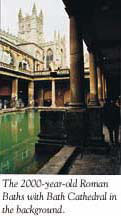Sussex
to Stonehenge: Nick Beykirch '00 and Patti McWhirr '00
 Our
first stop, the Weald and Downland museum, provided a frame of reference
for understanding the steady pace of rural development that served
as a backdrop for the pageant of English history and politics. This
living history museum contains some forty buildings, several of
which date back to the 15th century. These buildings were rescued
from many regions of England, taken down, moved, and then set up
as they would have existed when they were first constructed. The
museum showcases agriculture and architecture, as well as domestic
life. Costumed craftsmen, farmers, and villagers periodically re-enact
events from country life true in every aspect to their eras, and
will answer questions posed by visitors as long as no references
are made beyond the time frame they represent. Our
first stop, the Weald and Downland museum, provided a frame of reference
for understanding the steady pace of rural development that served
as a backdrop for the pageant of English history and politics. This
living history museum contains some forty buildings, several of
which date back to the 15th century. These buildings were rescued
from many regions of England, taken down, moved, and then set up
as they would have existed when they were first constructed. The
museum showcases agriculture and architecture, as well as domestic
life. Costumed craftsmen, farmers, and villagers periodically re-enact
events from country life true in every aspect to their eras, and
will answer questions posed by visitors as long as no references
are made beyond the time frame they represent.
Our first night's stay was in a 12th century water mill in the city
of Winchester. Converted to a youth hostel, it proved to be our
most primitive accommodation. Low ceilings and shower-rationing
aside, sleeping in an 800-year-old building impressed everyone.
We also discovered that hostels are fertile ground for meeting other
foreign and British travelers.  Winchester's
cathedral, built in 1079 and the longest in all of Europe, was not
its first. The earlier church, established by King Cenwealh in 648,
was a much simpler Romanesque building. Either structure, but especially
the Gothic cathedral, would have required feats of engineering difficult
to envision in light of the limitations of power sources and modeling
techniques available. Winchester's
cathedral, built in 1079 and the longest in all of Europe, was not
its first. The earlier church, established by King Cenwealh in 648,
was a much simpler Romanesque building. Either structure, but especially
the Gothic cathedral, would have required feats of engineering difficult
to envision in light of the limitations of power sources and modeling
techniques available.
Many of the cathedrals in England contain a range of architectural
styles, mainly because their completion spanned so many decades.
Salisbury Cathedral, however, was built in a mere thirty-eight years
by three hundred men. Its Chapter House is home to the Magna Carta,
and its soaring spire, dating from 1313, is the tallest medieval
structure in the world. Nick summarized the experience saying, "These
two cathedrals left me with a new respect for the artifacts and
techniques of past centuries, many of which were the bases for technologies
we use today."
We left Winchester early to visit Salisbury, site of another famous
cathedral, and Stonehenge, whose antiquity is nearly beyond the
scope of an American imagination. |
Glastonbury,
Bath, and Ironbridge: Christina Hoey '99 and Ken LeCompte '00
 Our
second day's travels brought us to the youth hostel outside the
village of Street, a suburb of Glastonbury. Glastonbury's abbey
ruin is its historical gem, with the well-preserved monastery kitchen
providing insight into medieval culinary technology. Our
second day's travels brought us to the youth hostel outside the
village of Street, a suburb of Glastonbury. Glastonbury's abbey
ruin is its historical gem, with the well-preserved monastery kitchen
providing insight into medieval culinary technology.
We recognized our high point in accommodations for the trip when
we approached Banwell Castle. This was the splurge of the trip,
though not expensive by American hotel standards. The country home
of a local squire, Banwell was built in Gothic revival style during
the 19th century, and its peacocks and four-poster beds delighted
our crew. It was the launching point for a thorough exploration
of nearby Bath, where a famous Roman spa was built on the site of
a long-revered natural hot spring. After the fall of Rome, Bath
declined until the 18th century, when it was rediscovered by  Georgian
society, whose architecture of honey-colored stone pervades the
city. Today the technology supporting the ancient Roman bath systems
is revealed and explained in detail at the Bath museums. Georgian
society, whose architecture of honey-colored stone pervades the
city. Today the technology supporting the ancient Roman bath systems
is revealed and explained in detail at the Bath museums.
The next morning the group prepared for a transition into a more
recent era, and by early afternoon we had reached Ironbridge Gorge.
Here, through the exploitation of coal, limestone, iron ore, and
clay, the community of Coalbrookdale along the Severn River was
thrust into the Industrial Revolution. Coalbrookdale became the
birthplace of the world's first iron wheels, rails, and boats, and
the cast-iron bridge for which the town is named.
This technological center of the late 1800s was perhaps most vividly
portrayed at Blists Hill, a recreated Victorian town whose costumed
docents occupied the various stores and workshops and were glad
to explain and demonstrate their crafts. Mining and steam train
operation were showcased, and the Blists Hill bank allowed us to
exchange modern pence for locally minted Victorian shillings. And
as Christina noted, "One of the great qualities of a living history
museum like Blists Hill is its ability to inform visitors not only
of technological developments but also of the people who made these
developments happen." |
|

